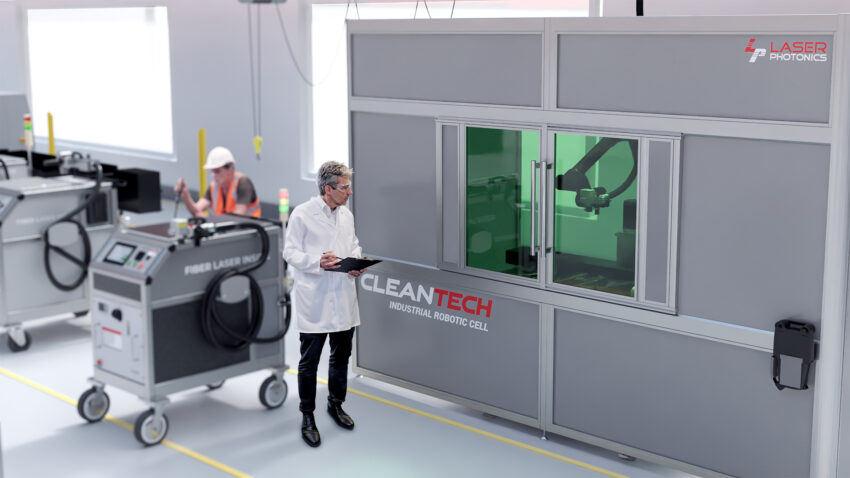Enclosed robotic laser parts cleaning systems are poised to safely remove rust and contamination as well as condition surfaces at dramatically higher volumes and at lower cost than messy, labor intensive conventional methods like sandblasting, dry ice blasting, and chemical stripping.
“Automated laser cleaning systems are designed to cost-effectively clean high volumes of even the largest format parts and equipment and can be tailored to suit the size and complexity of the parts, while eliminating concerns over operator safety,” says Wayne Tupuola, CEO, Orlando, Florida-based Laser Photonics (NASDAQ: LASE), a leading global industrial developer of laser systems for cleaning and other material processing applications.
A laser cleaning robotic workcell usually consists of at least one laser-wielding robot, controllers, and safety equipment in a custom, see-through enclosure. These collaborative robots, or cobots, excel at tasks like the laser cleaning of parts which involve repetition, freeing up employees to work on other activities.
With a system like the CleanTech Robotic Cell from Laser Photonics, the operator can lay out several components for cleaning over the flatbed, set the cleaning coordinates, and leave the robot processing.
Advancements in laser technology complement the efficient cleaning of materials of various sizes and shapes.
“Large format automated laser cleaning systems can expedite the processing of [applications like] automotive tire rims, molds, oil and gas flanges, or even sheets for the hull of a ship or other vessel,” says Tupuola. He notes that the size and configuration of the enclosures can be customized to accommodate the size and nature of the parts that require cleaning, with the lasers operating at a range of power levels.
Another significant benefit to such automation is improved operator and environment safety. For extra safety, custom-tailored automated laser systems are enclosed in a Class I safety workcell. OEMs can also integrate dust and residue collection, as well as a fume extractor that captures vapors during the cleaning of toxic substances.
This type of advanced laser cleaning equipment is designed to accommodate rigorous safety regulations. As an example, Laser Photonics’ CleanTech systems can help businesses achieve compliance with OSHA regulations and make environmentally responsible decisions in accordance with EPA’s waste management guidelines.
Unlike conventional methods, the laser cleaning systems require no consumables other than electric power, minimal labor, and minimal maintenance. The longevity and low-maintenance design of these industrial-grade robotic laser cleaning systems further adds to their value, increasing ROI, and making replacement unnecessary for decades.
For more information on laser cleaning solutions for surface preparation, contact Laser Photonics at (407) 804-1000 or visit www.laserphotonics.com.

